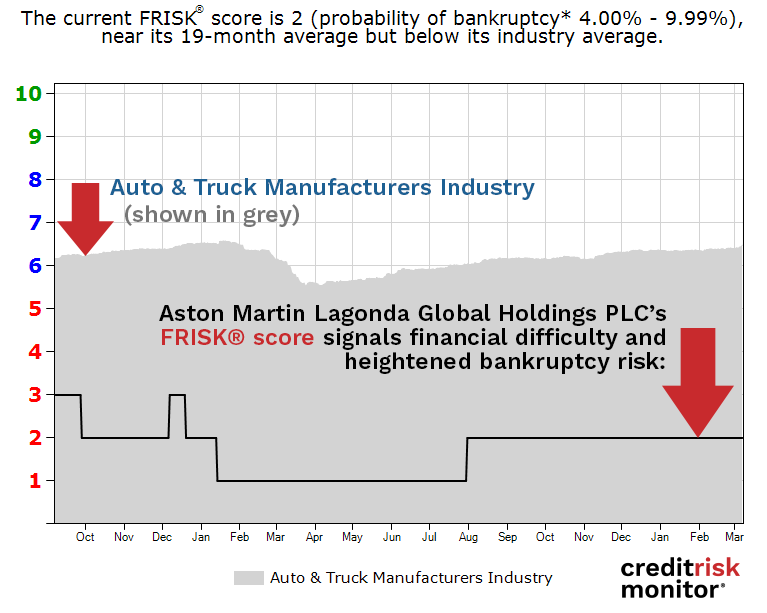Shut down the showroom? Iconic luxury auto manufacturer Aston Martin Lagonda Global Holdings plc has seen sales collapse and losses mount in a turbulent year that was overshadowed by management change and the coronavirus pandemic.
The British company's pre-tax losses almost quadrupled in 2020, though under new chairman Lawrence Stroll, it is aggressively forecasting to sell 10,000 cars per year by 2025. In a release, Mr. Stroll called 2020 a “transformative year” and reiterated that he was “confident in the future success of Aston Martin as we transform the company to be one of the greatest luxury car brands in the world.”
C-Suite bluster aside, the daily CreditRiskMonitor FRISK® score is bearish on Aston Martin. They currently sit at a "2," indicating swelling bankruptcy risk:

Our FRISK® Score model incorporates four powerful risk inputs:
- “Merton”-type model of stock market capitalization and volatility
- Financial ratios, including those used in the Altman Z”-Score Model
- Agency ratings
- Website click pattern data from CreditRiskMonitor® subscribers, representing key credit decision-makers at nearly 40% of current Fortune 1000 companies plus thousands of other large companies worldwide
Since the start of 2017, the FRISK® Score’s rate of success in capturing public company bankruptcy is 96%. In any given year, you can count on one hand the times we miss – and in those outlier cases, the circumstances deal with unusual, unforeseen events such as natural disasters and CEO fraud.
Download the free report to learn more.
About High Risk Reports
Our High Risk Reports feature companies that are exhibiting a significantly high level of financial distress, as indicated by our proprietary FRISK® Score.
The reports highlight the factors that have pushed a company's score lower on the "1" (worst) to "10" (best) FRISK® Score, which is 96% accurate in predicting bankruptcy over a 12-month period. The High Risk Reports also includes analysis on financial indicators such as the company’s DBT index, stock performance, financial ratios and how it is performing relative to its industry peers.
The ultimate goal of the High Risk Report series is two-part: provide an early warning for those doing business with an increasingly distressed company and inform of the many signals that should be examined when assessing financial risks.